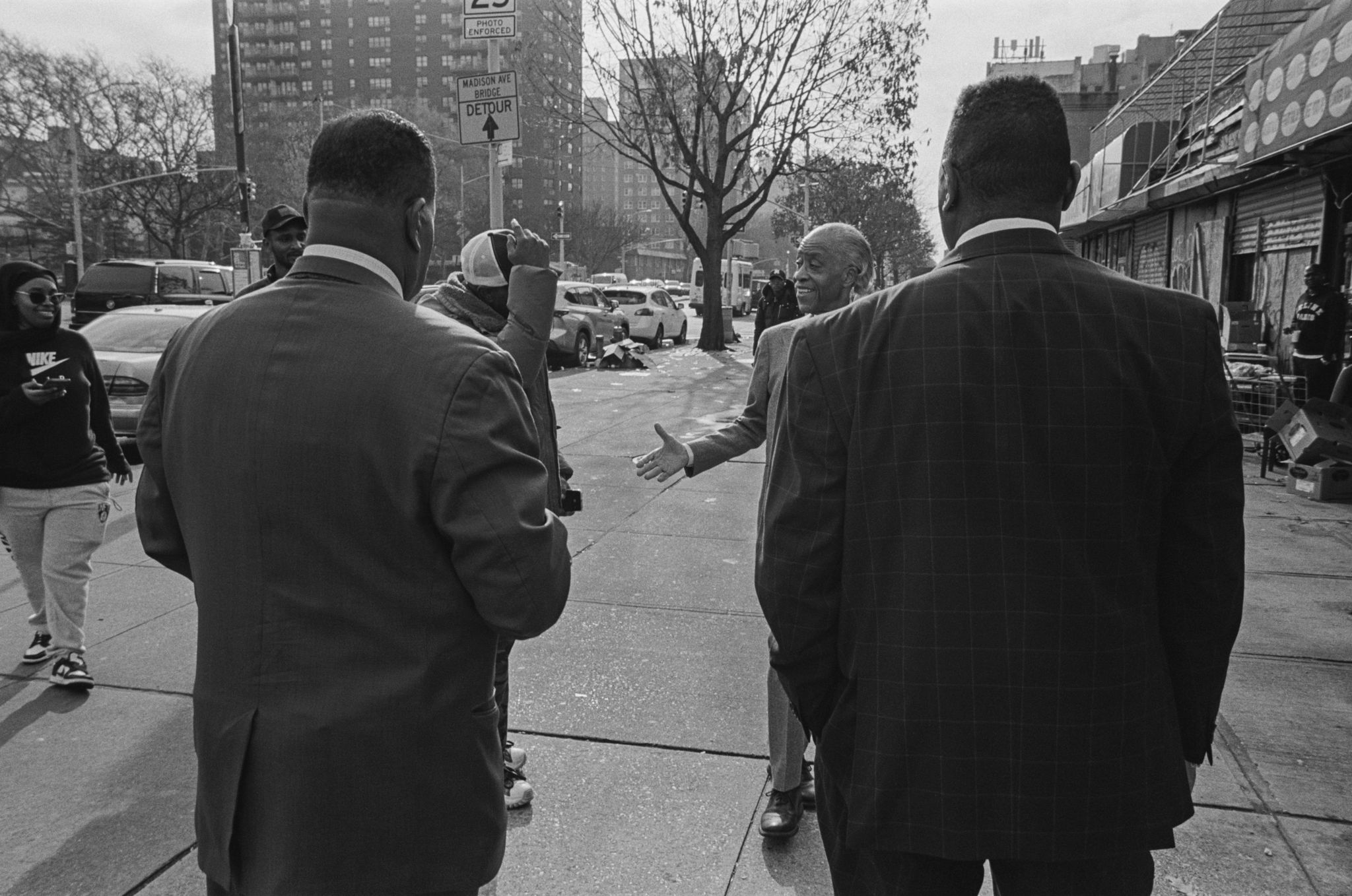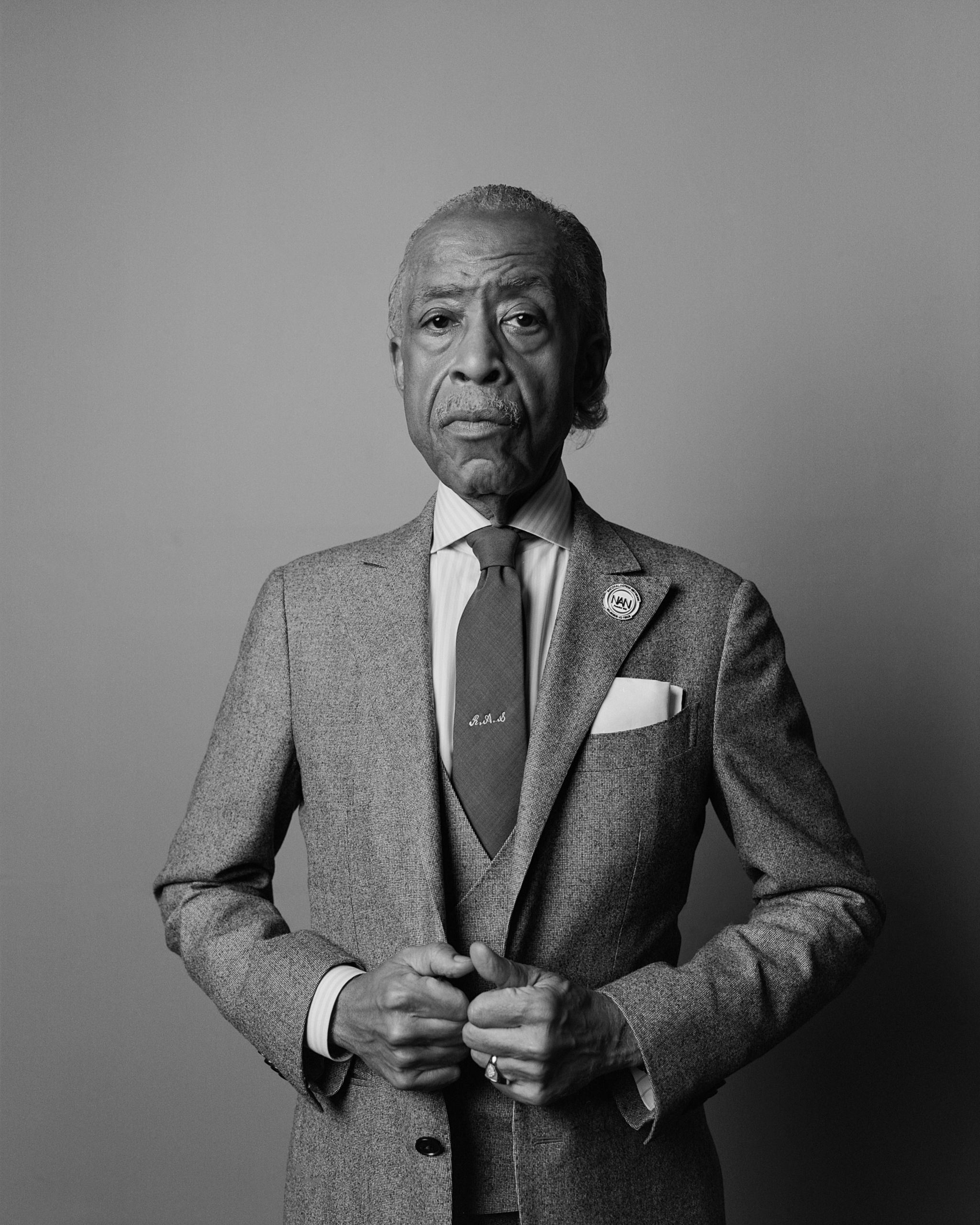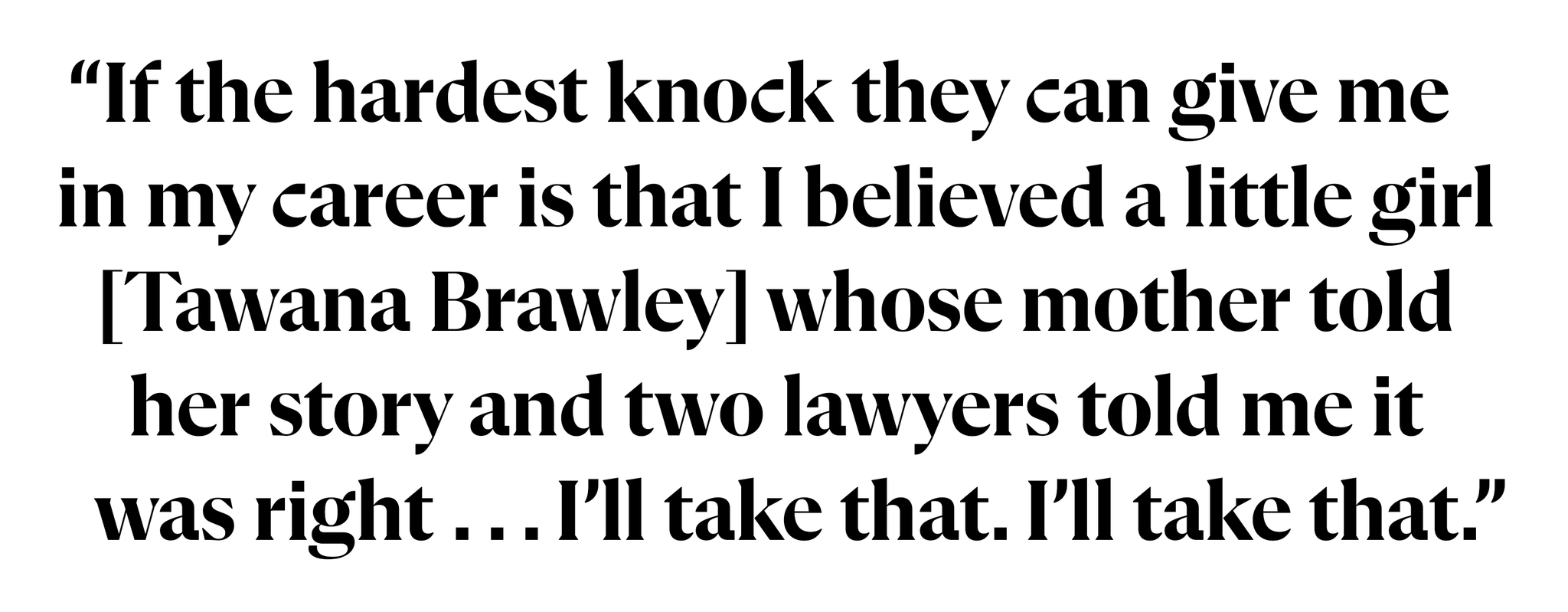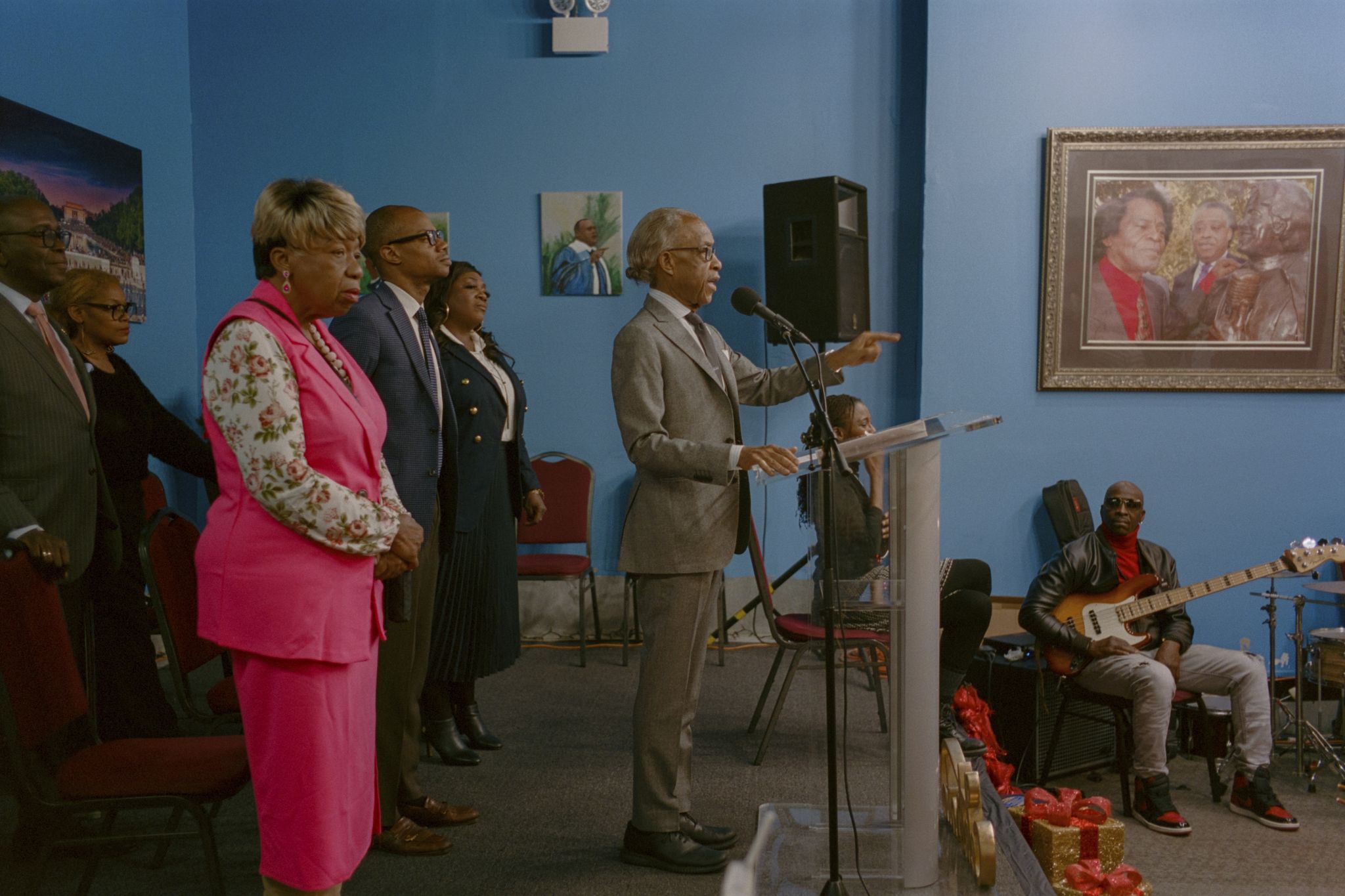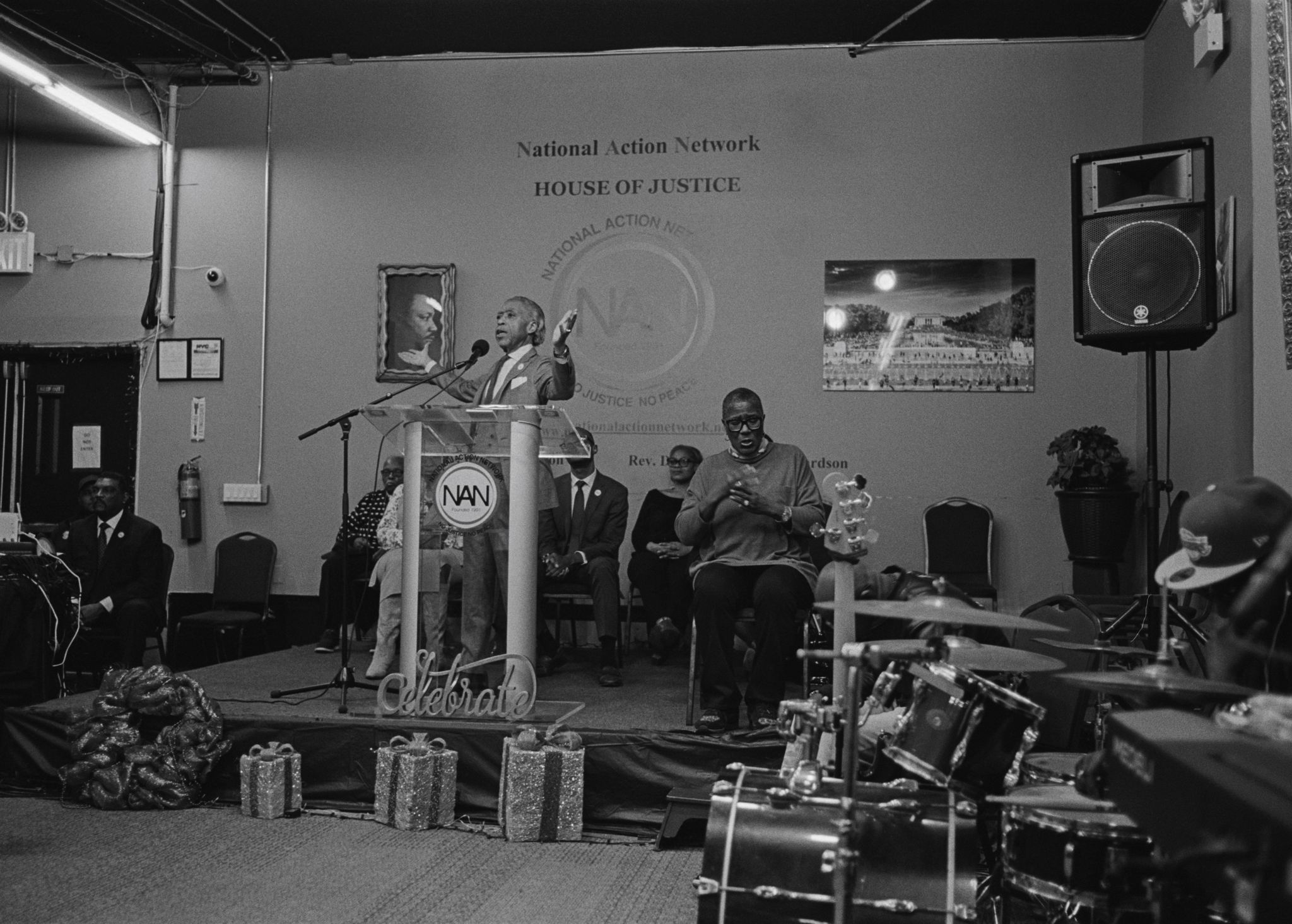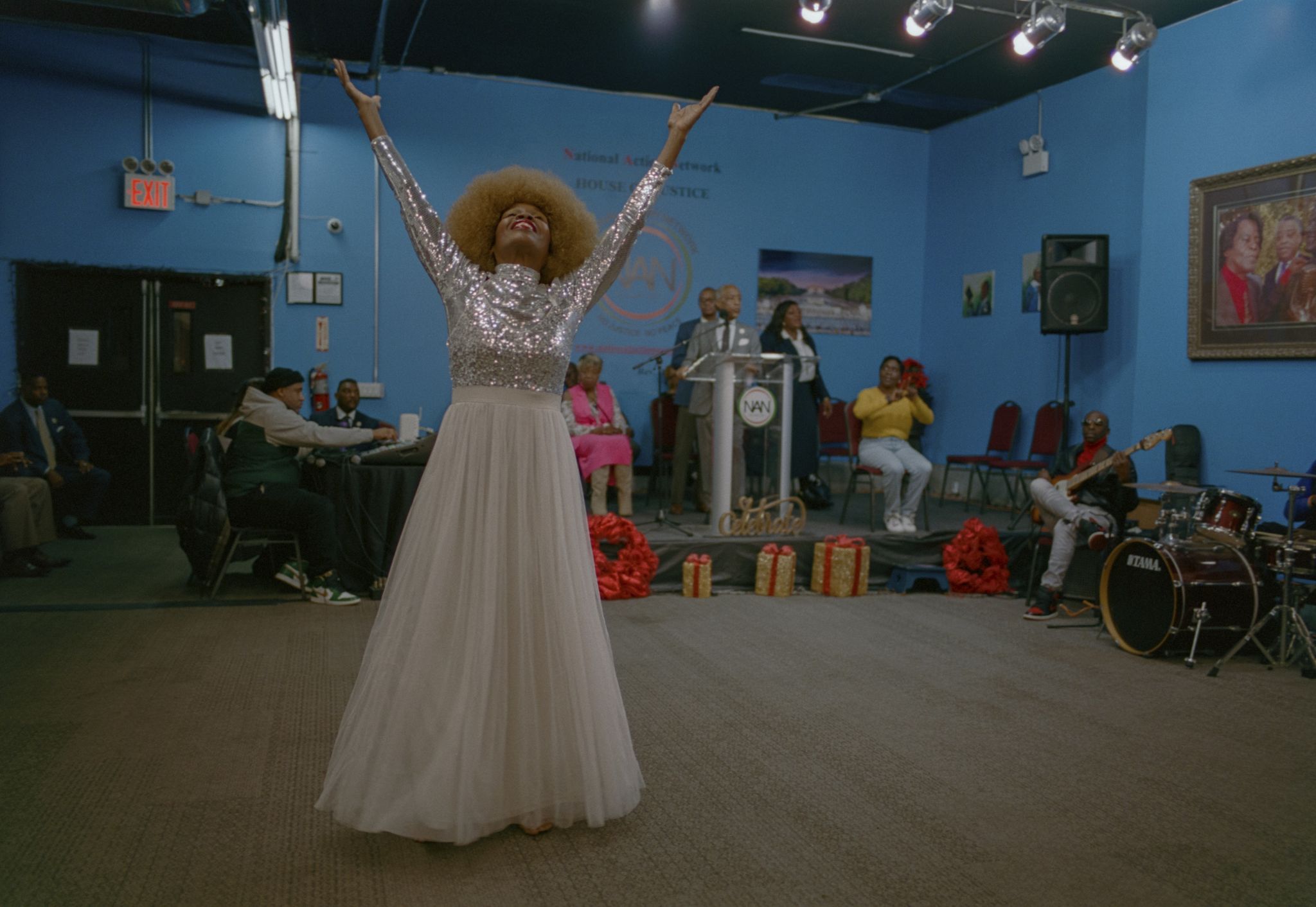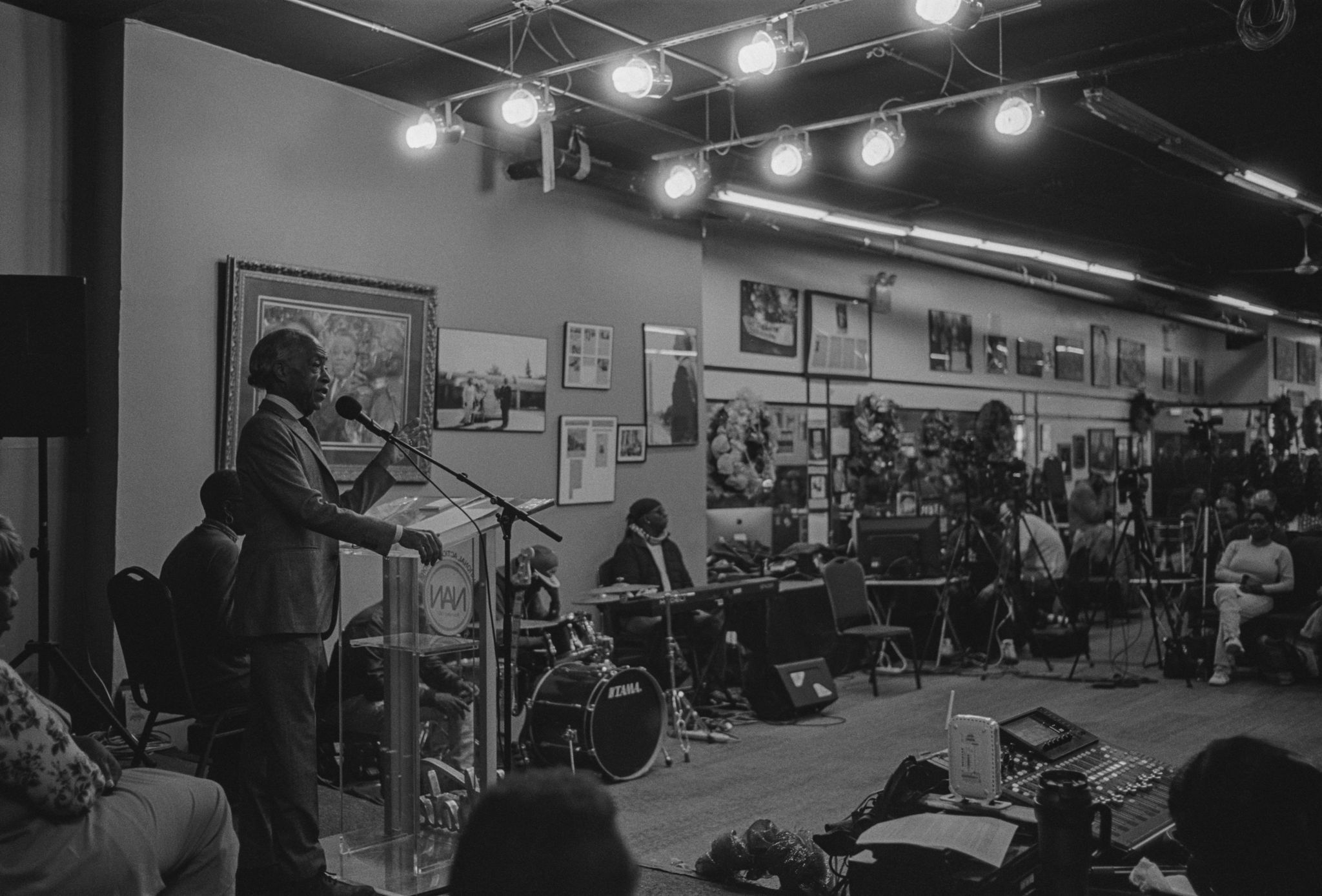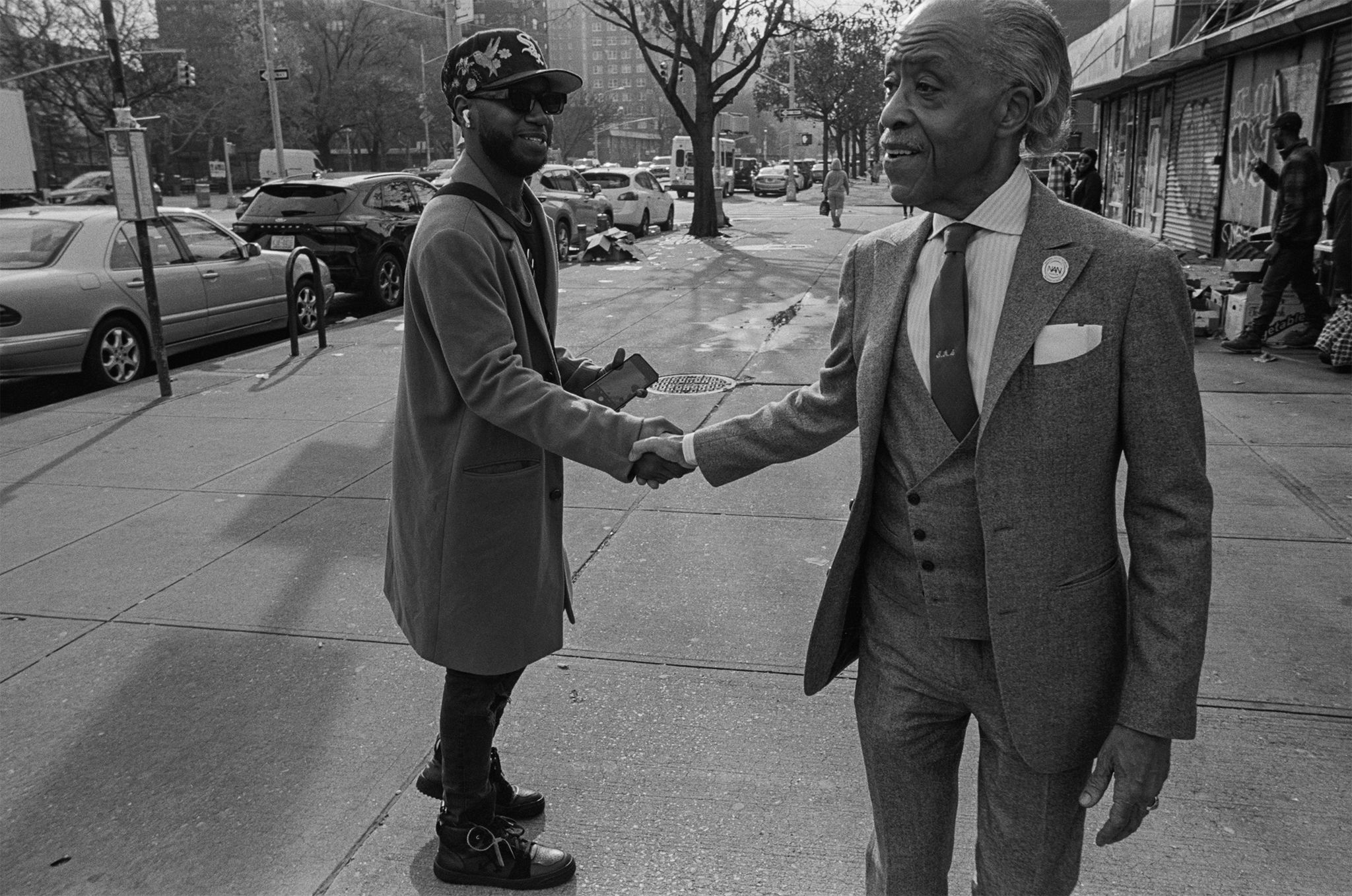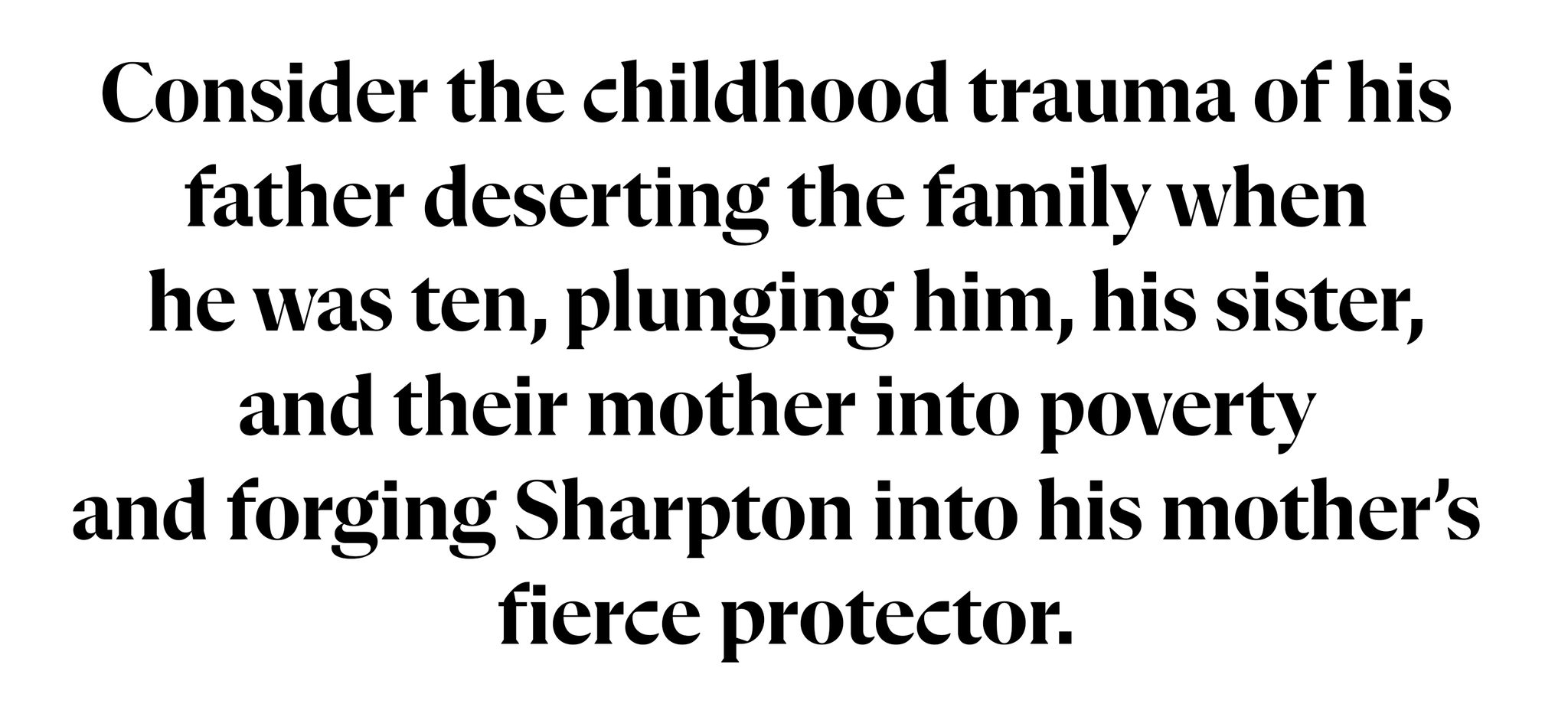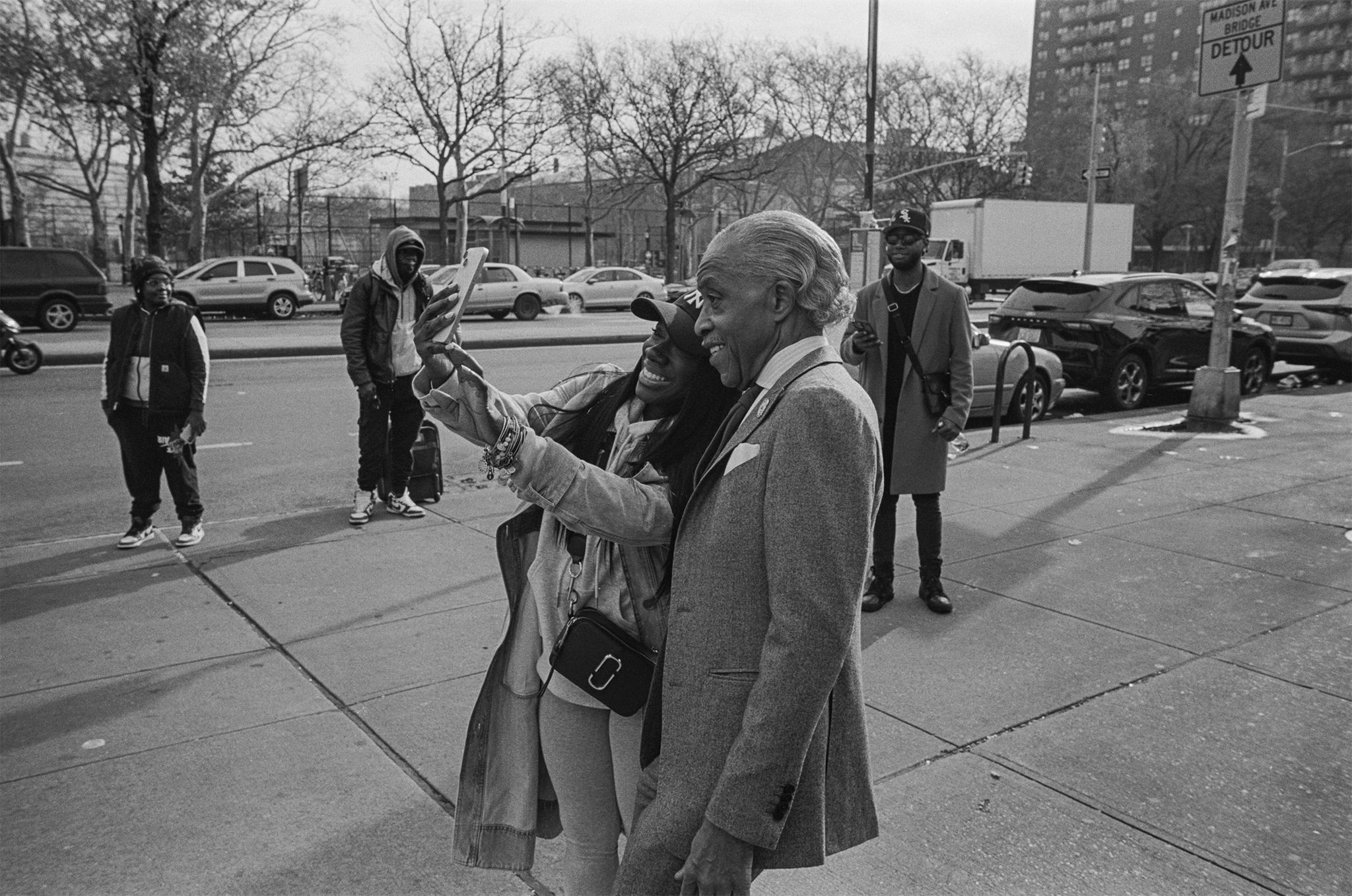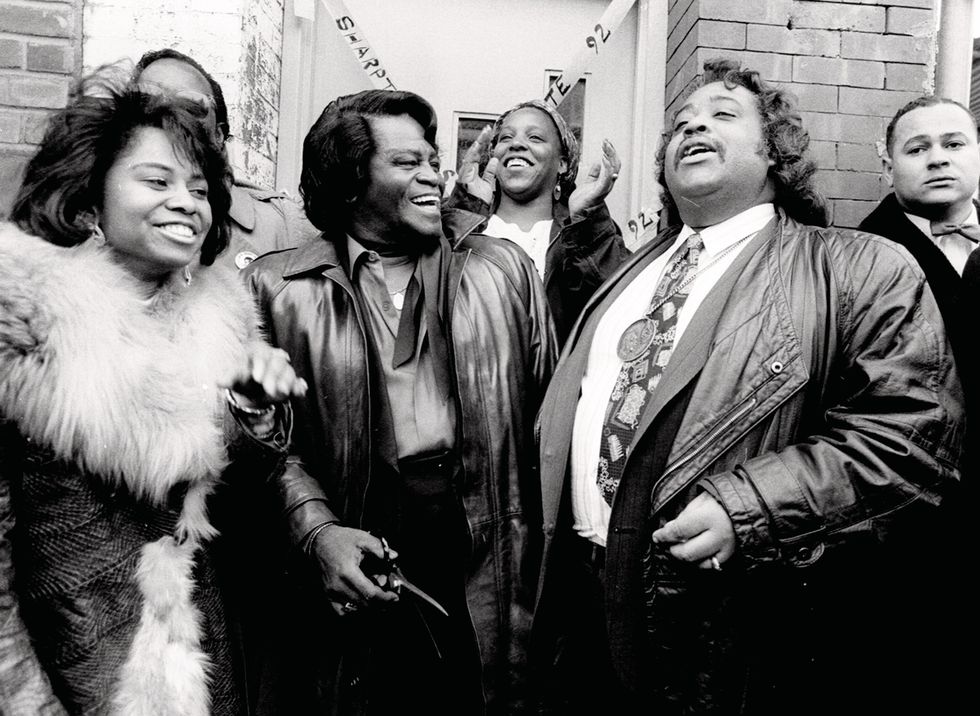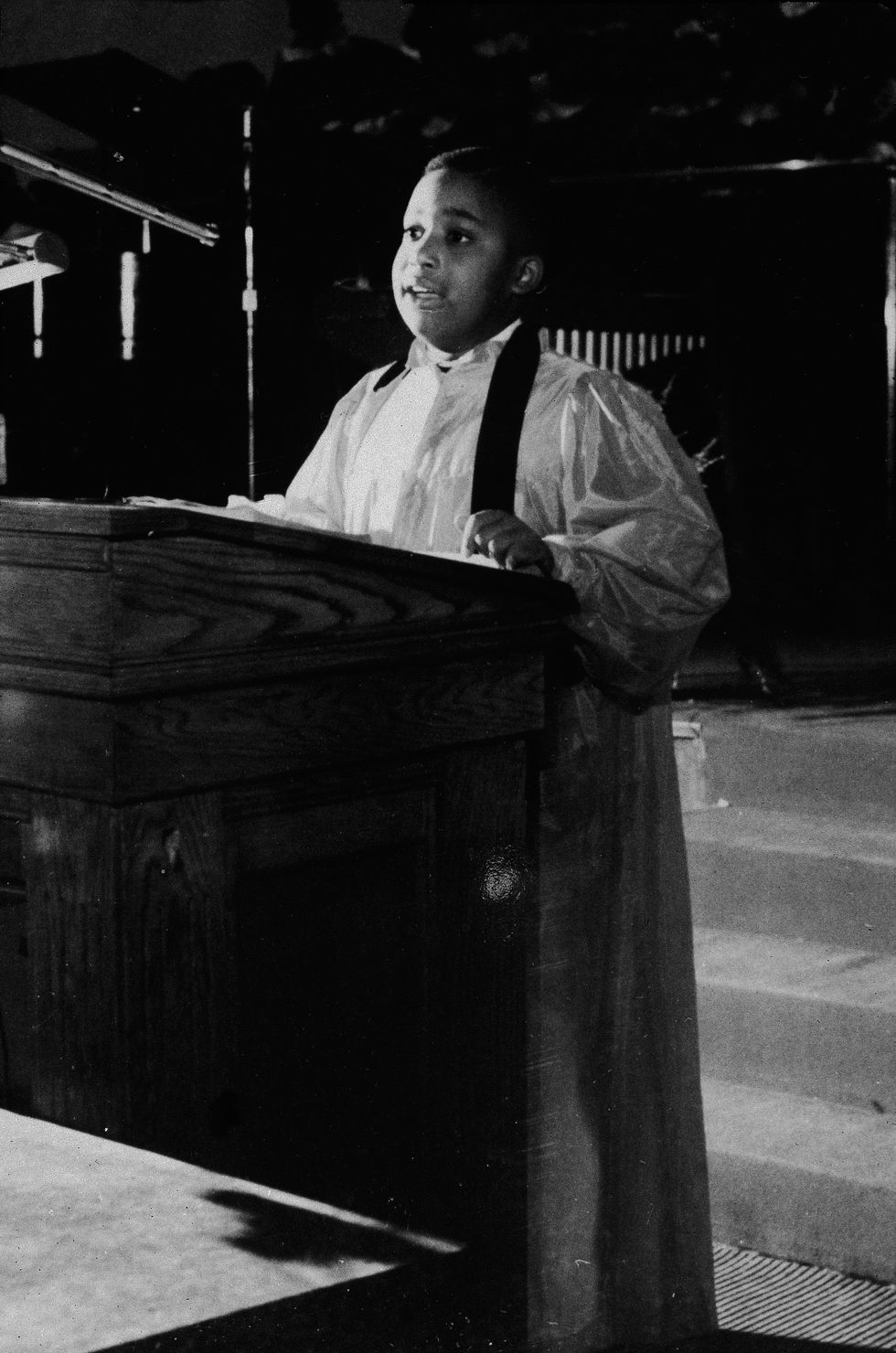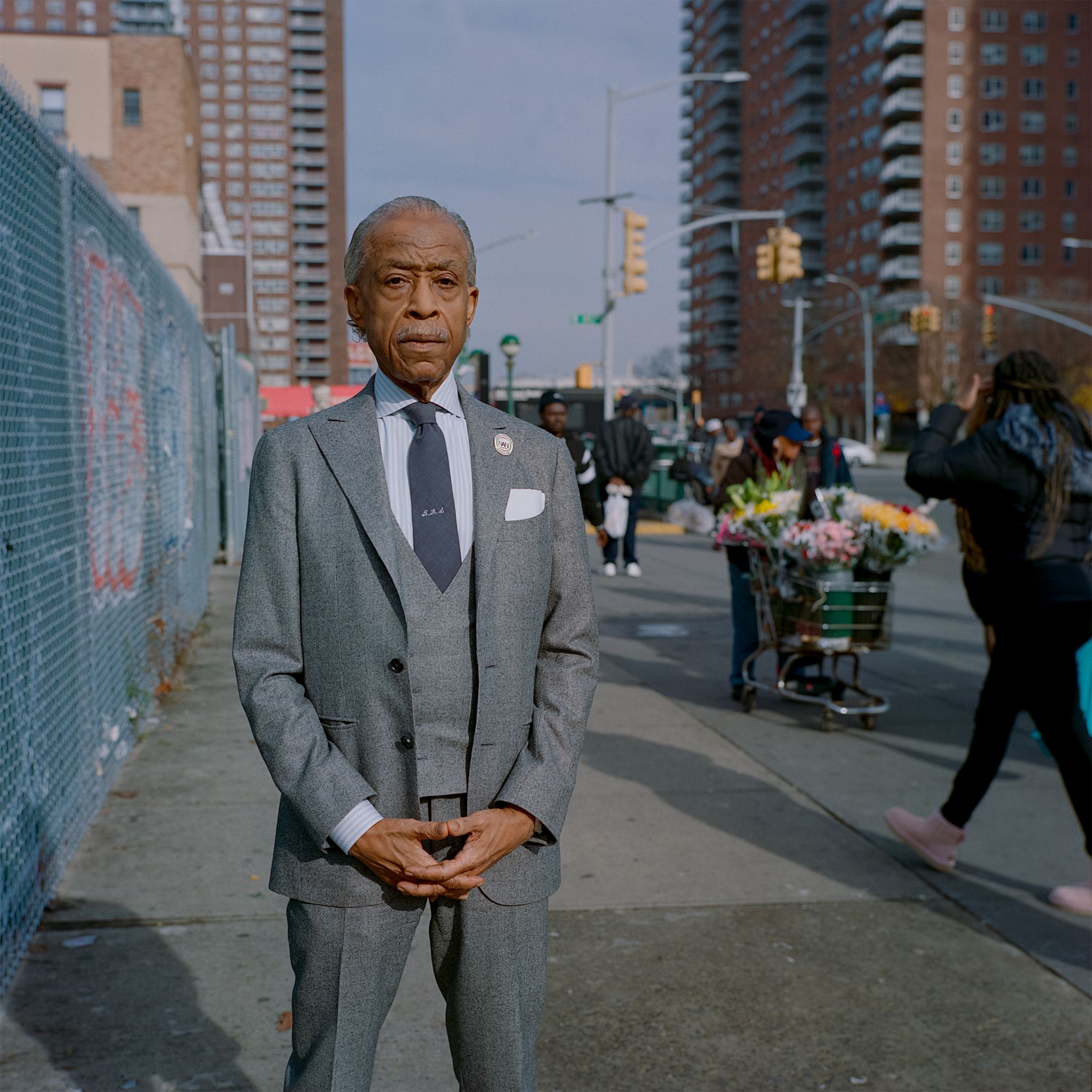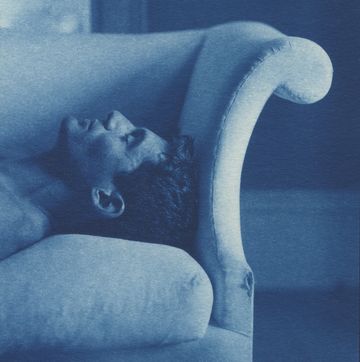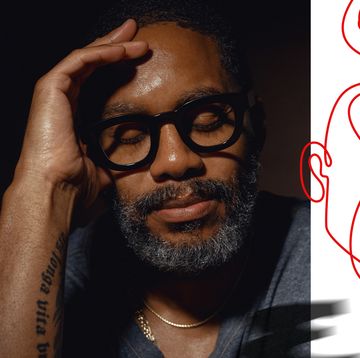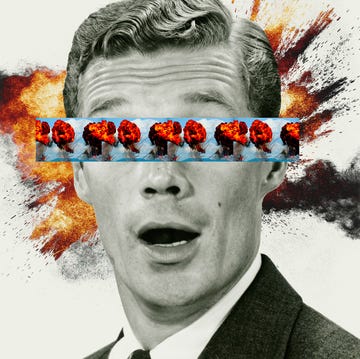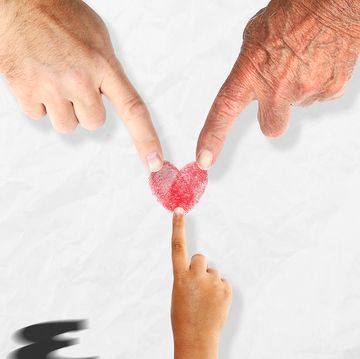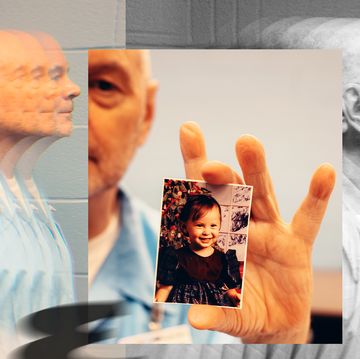WASHINGTON, D. C.
AUGUST 26, 2023
Can’t tell you what Martin Luther King Jr. was doing in the hours, minutes, before he delivered his “I Have a Dream” speech, but I can tell you that sixty years later, Alfred Charles Sharpton Jr. is sitting in an upholstered wooden chair in his trailer, parked on a fence line behind the Lincoln Memorial, fielding calls on his cell phone about today’s rally, at which he will deliver his own speech. Can’t tell you the logistical concerns MLK solved himself in the minutes before he gave his most famous public address, but I can tell you that Sharpton’s cell is ring ring ringing with handlers and schedulers panicked about the lineup, about having the event shut down by the National Park Service for the bureaucratic alibi that it has run past its permitted time.
On the umpteenth such call, Sharpton, who’s about as calm as an August breeze, tells the anxious messenger to get ahold of Stephen K. Benjamin, a senior advisor to President Biden, and have him handle it.
There were 250,000 people at the original March on Washington for Jobs and Freedom. But today’s continuation—that’s what he’s calling it, a continuation, not a commemoration—appears not to reach the 75,000 estimated by Sharpton and Martin Luther King III, two of its chief organizers. Still, King is present with his wife and their daughter, MLK’s only grandchild. And Sharpton? Coretta Scott King herself once described him as a leader “in the spirit and tradition of Martin Luther King Jr.” Nonetheless, over his long career as a rabble-rouser, there have been no few folks naysaying how well he has bent the moral arc of the universe toward justice, who’ve questioned whether he’s deserving of inclusion on the esteemed short list of civil-rights icons.
The trailer has a kitchen, bottled waters and half-dirty dishes scattered across its countertop. A dining table holds Sharpton’s briefcase and a bottle of his trusty Cool Mint Listerine—he swishes it as a habit to preserve his voice, which is tinged with natural rasp. Against a wall of fake bricks: one of the world’s tiniest flat-screen TVs and a gas fireplace. Sharpton wears a blue three-piece suit with a blue-and-white-striped tie, a uniform of empowered men from a certain era, of his era—the man is sixty-nine years old. He wears black oxfords that have the comfortable soles of sneakers, and the shoes aren’t new, proven by the white threads peeking around their top lines.
Sharpton’s cell keeps right on ringing.
Amid the fusillade of frantic calls, one turns out to be not from a worried handler but from the Reverend Jesse Jackson.
He who was here to witness (up close) the original “I Have a Dream” sixty years ago, he who made two serious runs for the presidency of the United States, he who is an incontrovertible civil-rights titan.
“Reverend,” Sharpton says, a warm smile in his voice.
Jackson responds, but Sharpton—whom most people call Rev and diehards proclaim is the president of Black America—can’t hear him, so he puts the call on speaker.
“I’ll come see you, Reverend,” Sharpton says.
Jackson’s health has been deteriorating, and he sounds to my ear unintelligible. But Sharpton, who speaks to his mentor on the regular, deciphers it.
What are the chances it would be Jackson calling right now? Jackson, who worked side by side with MLK. Jackson, who met Sharpton when he was a teen and helped nurture him into a leader. Jackson’s garbled voice in this trailer is a bridge to a long-gone past, from MLK’s admired activism to Sharpton’s much-criticized methods.
“Don’t worry about that,” Sharpton is saying to Jackson. “I’m going out there. I’m speaking for you. . . . You trained me to do it, and I’m gon’ do it. Don’t worry about it, Reverend. I’ll call you soon as it’s over.”
Sharpton hangs up his phone and says, “That was an omen.”
SOUTH CAROLINA
THREE WEEKS EARLIER
There may be no greater marker of evolution than the posterity of the once enslaved traveling by private jet to visit an old plantation. Sharpton has chartered one to see the South Carolina property on which his forebears worked as chattel.
The entourage includes about a dozen folks, counting Sharpton’s security detail, his personal photographer, and members of his communications team. The most meaningful travelers today are his daughters—Ashley, thirty-six, and Dominique, thirty-seven—who, because neither has visited, were the motivation for the trip.
A small delegation—local historians, folks whose ancestors were enslaved with Sharpton’s—receives him at an airport in South Carolina. We caravan in black SUVs (Sharpton doesn’t drive) to what used to be a plantation called Cactus Hedge. In 2007, Sharpton learned from a genealogist that his great-grandfather Coleman Sharpton Sr. was enslaved by pre–Civil War plantation owner Alexander Sharpton—a man who once owned more than four thousand acres of farmland and enslaved seventy-eight people—and that Alexander purchased Coleman for $276 in 1839. Sharpton also discovered that his great-grandfather was later enslaved by a relative of Strom Thurmond, the longtime South Carolina senator and staunch segregationist.
Old trucks, rusted to the color of clay, squat in a field. A fence of chicken wire surrounds the main house. You can hear chickens clucking, a pen of turkeys gobbling and yelping, see goats wandering. There’s a pit of rocks and twigs for a bonfire. The man who now owns the property, Phillip White, tells Sharpton that he bought it because he loved it, and it was cheap. (He says he paid $50,000 for the house and ten acres in 1983.)
White is squat, with a neck that doesn’t move much. He tours us through his two-story main house, large for its time at around two thousand square feet. He acknowledges the children’s toys scattered about the living room. He points out the breezeway, explains how the house stays cool because of the gaps in the wood flooring. He points to the thickness of the beams running across the ceiling and brags that they were hewn from heart pine. He shares that he didn’t know the history of the house when he bought it but that it was perfect, “just like it was a hundred years ago.”
No one reminds White that the idyllic life of a hundred years yore was smack in the crush of Jim Crow, an era when Sharpton or me could’ve been lynched for looking him in the eye or refusing to kowtow off his side of the street.
White tours us across a large field, a Kangal Shepherd dog the size of a dinosaur (150 pounds if he’s an ounce) that White swears is harmless bounding alongside us, to a shack that would’ve housed Sharpton’s great- grandfather and many others enslaved on the plantation. The shack, which is the size of a two-car garage, is made of rotting wood and has a rusted tin roof and a chimney of rock and mud. Sharpton stands in the doorway.
“This is where they would have to eat.” A question and statement in one.
“Exactly,” says White. Sharpton calls his daughters over, and they all stand near the front door, gazing around the room. They take a photo at the threshold. It’s a striking photo. There’s no way to ignore the sorrow in their eyes.
White explains more about the daily life of the Black people who lived on the plantation. “They had cows, beef. They had a big garden. So they ate good when they lived here,” he says, sounding earnest.
“But they were slaves,” Sharpton shoots back.
The enslaved were not given headstones, but there’s a strong chance that some of Sharpton’s relatives are buried in unmarked graves beneath a nearby gravel area.
Soon we’re trundling along Sharpton Road on the way to the cemetery where Sharptons are buried—white Sharptons. Al Sharpton is ensconced in the SUV again, a soft briefcase stitched with the insignia of the National Action Network (NAN), his organization, beside him; his cologne, Al Haramain’s Amber Oud, fragranting the cabin. He wears a silver Rolex and a diamond insignia ring with his initials. Up close, his hands are a shade or two lighter than his face. He keeps his nails trimmed short.
Sharpton, Ashley, and Dominique stroll the Bermuda grass between the headstones to a row where Alexander and Adeline Bussey Sharpton lie. Sharpton holds his phone in one hand and keeps his jacket buttoned. He and his daughters look over more headstones, some of which are large and dressed with fresh plants and bouquets, some of which belong to Thurmonds.
It is one thing to be Black and know that, generations ago, white people owned your forebears. It is quite another to be standing at the foot of the gravestones of those white people and their posterity and considering that the surname that’s become a crucial part of who you are is theirs. And that’s the feeling I see wash over Ashley and Dominique.
On the private flight back, the captain offers snacks, which Sharpton declines. His ascetic diet consists of one meal a day: kale salad, boiled eggs, tomatoes, and cucumbers. Sometimes he has a green juice in the morning. Sometimes he snacks on a piece of dry toast. Matterfact, over the two-plus months I spend with him, I don’t see the man eat a single meal. This version of Sharpton is svelte, polished, measured, wears bespoke suits and has the bearing of a statesman.
HARLEM
JUNE 10, 2023
Every Saturday, clockwork, Sharpton can be found at the Harlem headquarters of NAN—a building long ago christened the House of Justice by Jesse Jackson—holding his Saturday Action Rally. There’s not much difference between the House of Justice and a storefront church, right down to its location smack between a Kennedy Chicken & Biscuit and a bodega, to the graffiti tagging its weathered facade, to the speaker just above the threshold blasting the goings-on inside.
There ain’t much difference, either, between the “rally” and who you’d find at an eclectic nondenominational Black church service. A little girl in a white dress holding a NAN fan. A guy in the front row shooting the happenings on a pair of cell phones, one in each hand. A woman wearing a gay-pride sash—she was at the Stonewall riots in 1969—dark sunglasses, and a tiara. All of them sitting in padded interlocked chairs, save a man capping an aisle in a wheelchair. Along one wall, a three-piece band (drums, guitar, keyboard) plays stirring gospel. The choir sings in front of the pulpit, a low wooden platform with a simple branded podium.
Those blue walls of the House of Justice are a gallery. Above the band, there’s a giant framed photo of Sharpton with James Brown, maybe the most important man in his life. There are photos of Sharpton with President Barack Obama, with President Biden, with former attorney general Eric Holder. Him consoling the mother of Sean Bell, shot to death by the NYPD on his wedding day in 2006. There are framed clippings of Sharpton from The New York Times, the Amsterdam News, the New York Daily News. The cover of Newsweek. A blown-up version of him on the cover of Ebony.
Dominique, as well as Sharpton’s ex-wife (and the mother of his daughters) Kathy Jordan, joins the choir to sing “Never Give Up,” which rouses the room to its feet. During a long pause in the song, Sharpton strolls out wearing a dark-gray suit, a striped tie, and black dress shoes. He takes the lectern and gazes at the room.
“No justice,” says Sharpton.
“No peace,” says the audience.
“No justice,” says Sharpton.
“No peace,” says the audience.
“No justice.”
“No peace.”
“What do we want?”
“Justice!” shouts the audience.
“What do we want?”
“Justice!”
“When do we want it?”
“Now!”
“Fist-bump the person next to you and tell them you love them,” he says.
Sharpton begins his sermon by discussing the history of civil rights, half- joking about fly-by-night protesters who say, “I ain’t gon’ take no more”—and then at the next incident can’t be found. The crowd laughs. “I want young folk that will be here for the long haul,” Sharpton says, “that understand that this is not a seasonal struggle. And the reason I know that is that I was raised by those who understand this was going to be a long struggle. I was young, wild, crazy, and mad as anybody else. I understand all that. But after a while you understand that you got to deal with pacing yourself for the long haul.”
The rally will include a red-pantsuited, red-wigged, red-lipsticked woman praise-dancing in bare feet. The “NAN Freedom Runner,” a dude in an orange T-shirt and dark aviator sunglasses, dashing laps around the floor to people cheering, “Run, Jesse, run! Run for our freedom!” Will include Sharpton standing on the edge of the platform to collect tithes and calling both the name of the person and the amount of their offering. “All right, I need some fifties, fifties, fifties, come on,” he goads, after the first few hundred- dollar-or-better donations.
These people, most of whom must be as distant from the citadels as one gets, are Sharpton’s flock, the core of his constituency, too, the ones he can call up and, quick-fast, get them raising signs and shouting outside a building or somebody’s home.
In the 1980s and ’90s, Sharpton was a fried-chicken-gorging behemoth of a man seen all around New York in a tracksuit, a medallion, a bouffant conk, and big muttonchops as he bullhorned protestations of racism and bigotry and injustice using a helluva lot of language MLK wouldn’t have dared utter in public—the n-word, cracker, “Uncle Tom,” analogizing a New York attorney general to Hitler.
In his time as a national figure, he’s been exposed as an FBI informant (“In my own mind I was not an informant; I was cooperating with investigations,” he told reporters), been reported by The New York Times to owe millions in personal and business taxes combined (he called the story “misleading”), pleaded guilty to failing to file a state personal income tax return, been alleged to have been several months in arrears on rent. He was indicted (and acquitted) on sixty-seven counts of fraud and larceny. Indicted for (and acquitted of) stealing $250,000 from an organization he founded. He’s been labeled the Minister of Hate, a “practitioner of the big lie,” and a “race racketeer.” Been called an ambulance chaser, a loudmouth, a walking sound bite, a media hound, a charlatan, a buffoon, a fake . . . damn near everything but, as we say, a child of God.
Only he was a child of God, and a precocious one at that.
Even before he attended kindergarten, Sharpton preached for his church, sermonizing on the Gospel of John from a soapbox placed in front of his church steps because he was too small to be seen in the pulpit. He was four. By the time he was seven, he’d been christened the Wonderboy in Black church circles. Sharpton’s mother steered her wondrous son into the mentorship of Bishop F. D. Washington, who began taking Sharpton all around the country to preach. Sharpton sought out Adam Clayton Powell Jr. on his own accord, and one of the most powerful Black men in America at the time became his earliest political mentor.
Worried he’d abandon the church for political activism, Sharpton’s mother shepherded him to the Reverend Dr. William Jones, who made Sharpton the youth director of the New York chapter of Operation Breadbasket, the economic arm of MLK’s Southern Christian Leadership Conference. Sharpton soon met the national director of Operation Breadbasket: the young, hip Reverend Jesse Jackson.
Powell, Jones, and Jackson helped mold Sharpton from the Wonderboy preacher into a wunderkind activist, a boy who founded his first civil-rights organization, the National Youth Movement (NYM), with money he’d received from MLK’s former close advisor, Bayard Rustin.
Sharpton was just eighteen, in 1973, when he met James Brown, whose son had attended NYM meetings. Brown’s son died in a car accident, and to honor him, Brown reached out to Sharpton and performed a fundraising concert for the NYM. Before long, Brown and Sharpton’s relationship deepened. Sharpton married one of Brown’s former backup singers, Kathy Jordan, and they had Dominique and Ashley.
Sharpton spent the eighties marching, agitating, protesting. Building relationships with sundry figures: Don King, Michael Jackson, and Donald Trump, a man he now describes as a “polished bigot.” In 1984, Bernhard Goetz, a white man, shot four Black teenagers on the subway (he claimed he was afraid they were going to mug him), and Sharpton’s activism played a role in Goetz’s being convicted of illegal possession of a firearm.
Sharpton’s breakthrough happened two years after the shooting. Three Black men had been beaten in Howard Beach, Queens—and one of them, in trying to escape, ran onto the Belt Parkway and was hit by a car and killed. Howard Beach was the first time Sharpton took his protest to a white neighborhood, a tactic that disabused more people of the lie that virulent racism was less of an issue in New York. Three of the white attackers were convicted of second-degree manslaughter. Sharpton, with a showman’s knack for hyperbole, later proclaimed it “the first public awakening of northern racism.”
During the trial for Howard Beach, in 1987, Sharpton became involved in the case of Tawana Brawley, a fifteen-year-old girl who told a disturbing story about being abducted and raped multiple times by six white men, including a cop and an assistant DA. Sharpton and her lawyers alleged a cover-up and discouraged Brawley from testifying. But after several months, testimony that amounted to six thousand pages, and 180 witnesses, a grand jury ruled her claim false.
Sharpton didn’t concede. Not after the verdict. Not after Brawley’s ex-boyfriend claimed she’d invented the story to avoid being beaten for running away. Not after he lost a defamation case. (A group of his supporters paid $65,000 in damages to the former assistant DA.) Not in the almost forty intervening years.
“I believed a young lady and her mother and two lawyers, a risk that I took in the thirty-something years since then,” he tells me. “How do I know that they weren’t going to come with something on George Floyd? How did I know they wasn’t going to come with something on Trayvon? And if the hardest knock they can give me in my career is that I believed a little girl whose mother told her story and two lawyers told me it was right . . . I’ll take that. I’ll take that.”
But Brawley remains a major blemish on his career, one that provokes fair questions: Why did he go so hard for her? Was he chasing notoriety at the expense of truth? Isn’t believing a possible but somewhat specious story in a charged moment different from remaining adamant after overwhelming evidence and the benefit of hindsight? Why hasn’t he expressed serious contrition? Is it ego holding him back? Hubris? Isn’t there wisdom, kindness, grace in offering an apology?
Whatever you think about Sharpton’s handling of the Brawley case, though, consider how often a man in his position has had to believe in what sounded impossible. Consider the truth that he’s spent his adult life fighting injustice, too often at the hands of law enforcement. Consider the childhood trauma of his father deserting the family when he was ten, plunging him, his sister, and their mother into poverty and forging Sharpton into his mother’s fierce protector. Consider the cultural imperative for Black men to protect our women, so much so that it was once the namesake of proposed legislation. Consider that Sharpton was a brand-new father at the time, that he would return home to Ashley as an infant and Dominique not long out of infancy.
However much you disapprove of Sharpton’s defiance in the Brawley ordeal, weigh it against his evolution since then.
Begin, maybe, with this watershed, in 1991: Sharpton was stabbed while preparing to protest the murder of Yusuf Hawkins, a Black teen who’d been attacked, shot, and killed by a white mob in Bensonhurst, Brooklyn. “There’s still too much racism in the country,” he told Jesse Jackson from his hospital bed. “And if I survive, I hope I’m going to be even more serious now in the true King tradition of opposing it.”
Sharpton ran for U. S. Senate in 1992 and 1994. He ran for mayor of New York City in 1997. He ran for president in 2004. He lost all those elections, which wasn’t no big old surprise to him nor anybody, really. But he won a preponderance of the Black vote and nearly 15 percent of all Democratic primary votes cast (166,000 out of 1.2 million) in his 1992 bid and more than 25 percent (178,000 out of 700,000) in 1994—all achieved with budgets of $100,000 or less both times—and quantified himself as a legitimate political force.
Sharpton, for all his old bluster, has remained true to MLK’s central tenet of nonviolence. He’s become a popular TV pundit and radio host. He might well be the most esteemed eulogist in Black America. He helped organize a rally in support of George Floyd during the pandemic that he estimates at two hundred thousand—the accomplishment that makes him most proud.
What if Sharpton’s ultimate legacy is not some omnibus writ that the ill- intentioned—looking at you, SCOTUS—will work lifetimes to dismantle but his indefatigable insistence (he logs a staggering 250,000 to 300,000 air miles per year) on the overtruth that there never has been nor will be a post-racial America, least of all in the city that is its locus of power. It’s not the bright, tangible achievements of his forebears but the difficult, often fallible work of steadying a light that won’t let you look away.
MOUNT VERNON, NEW YORK
JUNE 11, 2023
Sharpton has agreed to fill in for the pastor of Greater Centennial AME Zion Church in Mount Vernon, New York, and arrives preacher clean in a gray suit, a light-blue French-cuff shirt, links, his trusty NAN lapel pin. Before the sermon, he hosts his radio show, Sunday Morning with Rev. Al Sharpton, in a small conference room. The second he signs off, Sharpton turns to the Reverend Malcolm J. Byrd, a protégé, and says, “Bible.” Sharpton spends a few minutes, tops, looking over pages. “Okay, ready,” he says.
He sits in a velvet chair in an elevated pulpit, nodding to the mellifluous sound of the choir behind him. Reverend Byrd introduces him as the finest preacher “south of heaven and north of hell” and “a spokesperson of truth and liberation of the first magnitude,” what seems an impossible promise.
Sharpton preaches a sermon that ends with a story about letting a white reporter accompany him to church while profiling him. He says the reporter asked him about a woman in the congregation who kept leaning over in the pews like she was going to fall, then snapping straight. “Oh, you don’t know that lady’s story,” Sharpton says, switching to the drawn-out delivery of a southern whooping preacher. “That woman brought herself up from the South. She got married. Her and her husband had a little construction company. They did well and moved out to a middle-class section of Queens, New York. Used to buy a Cadillac every year. One day she woke up and her husband had walked out with her daughter from an earlier marriage. Had a child with his stepdaughter. Abandoned her and her little boy and her little girl. She ended up watching them come and take the Cadillac back. She tried to keep the bills going, but they turned the lights and gas off. She couldn’t pay the utilities. Finally, she couldn’t keep the house any longer. She had to move into the heart of the ghetto. She got on welfare and got food stamps. Did side jobs as a domestic worker. Her little boy would walk her to the subway to go downtown to scrub floors. And she would tell him, ‘Don’t worry about nothing. God will make a way. I don’t know where. I don’t know how. But God will make a way somehow.’ And she lived to see that little girl and that little boy grow up to be somebody. And when she thinks about how she lost everything but God brought her through anyhow and brought her children through, her little girl and her little boy through, she jumps up out her seat, leans to the side, and just jumps up and down,” Sharpton says, and mimics the motion.
“And the reason I know her story is because I’m her little boy,” he says, and in one of the sublimities of the Black church, the organist stresses his pause as if it’d been rehearsed. “He walks with me,” he shouts, to more organ accompaniment. “He talks with me. He tells me that I’m his own. God will. God will. God will. Make a way.” Sharpton wings his arms and points to the front row. “Yes, he will. Yes, he will!” he says, and steps away from the mic.
No “thank you,” no pause to relish applause, just an abrupt turn from the lectern. His hallmark.
SHARPTON HOME
JUNE 11, 2023
Sharpton answers the door to his apartment on the Upper East Side of Manhattan wearing a dress shirt, unbuttoned at the throat but tucked into his slacks, and slides with socked feet. Per public records, NAN paid Sharpton just shy of $650,000 in compensation as its CEO and president in 2021, plus spent almost $1 million more on private jets and car service. That income, combined with his salary from MSNBC—his talk show, PoliticsNation, often boasts the highest concentration of Black viewers on cable news—radio gigs, and speaking fees, places Sharpton in the top 1 percent of American earners.
He leads me outside to show me the view from his wraparound balcony, a remarkable sight, which is furnished with a small couch and a low table. He tours me past the office of his partner, forty-five-year-old fashion designer Aisha McShaw, with whom he made his relationship public in 2013.
Sharpton’s home office is like another vault of his archives. Above the desk hangs an old program, the kind some churches give out, advertising “The Rev. Alfred Sharpton Jr. A dynamic 7-year-old minister.” There’s a picture of Sharpton with his father, both dressed in church robes. A picture of his first grandson alongside his older daughter and the boy’s father. A picture of Sharpton holding his grandson, the boy decked out in a paperboy hat and with his fist in Sharpton’s mouth. A picture of him with James Brown, back when Sharpton had an Afro, both smiling and raising a Black-power fist. A picture from 1971, when he participated in a sit-in at an A&P. A picture of him on Saturday Night Live. There’s a stack of headbands just above his desk.
At his dining-room table, the sound of his TV playing an MSNBC show in the background, Sharpton tells me about the men who shaped him.
There would be no Reverend Al Sharpton without Bishop Frederick Douglas Washington, who was not only one of the most well-regarded Pentecostal preachers in the country but the pastor of Sharpton’s childhood church. Bishop Washington, a former boyhood preacher himself, allowed Sharpton to preach in public for the first time—July 9, 1959—and thereafter became his first mentor, someone who encouraged him to preach once a month and modeled the reading practice of a philomath. See the influence of Bishop Washington’s preaching style—it ranged from sound homiletics to the high emotion of the southern whooping tradition—in the way Sharpton commands a pulpit.
There would be no Sharpton without Adam Clayton Powell Jr. Sharpton met Powell at his church, the historic Abyssinian Baptist, when he was twelve years old, an experience that made him think he’d “seen God.” Powell began letting young Sharpton tag along while he held court around the city with everybody from the New York elites to its poor. Powell was a statesman and a pioneer of civil rights. (He led a bus boycott in Harlem fourteen years before MLK did in Montgomery.) He was irreverent to white power and had a flair for flamboyance. See Powell’s influence in how Sharpton has navigated the cultural and political milieu of New York, in his unabashed boldness.
Wouldn’t be an Al Sharpton without Jesse Jackson, whom he met as a teen when Jackson came to New York for a rally and the ribbon cutting of the city’s Operation Breadbasket office. Jackson was the organization’s national director and had established Saturday-morning rallies in Chicago, which drew thousands each week to hear him preach in person and on the radio. He was also, Sharpton noticed, full of swagger—at one point sporting a huge Afro and medallion—a young man who in many ways eschewed the aesthetic values of the older civil-rights leaders. See Jackson’s model in the fact that Sharpton has never pastored his own church, in the existence of his Saturday Action Rally, in the tracksuits and medallions Sharpton wore for decades, a defiance, too, of what a leader should look like. See it in how Sharpton struts around to handle his business.
There would be no Al Sharpton without Martin Luther King Jr. While Sharpton never spent significant time with MLK, as a boy he met him in Brooklyn while King was convalescing from a stab wound, later saw him preach at Washington Temple, and ended up working as the youth director of the New York chapter of MLK’s Operation Breadbasket. Still, MLK’s most enduring impact on Sharpton was posthumous. Sharpton was home watching TV with his mother the night that news of King’s assassination aired, and it made her weep as though she’d lost a family member. Sharpton asked his mother why she was so emotional. “You would’ve had to have grown up in Alabama”—Dothan—“like me and sit in the back of the bus, or have to use the bathroom and you wasn’t allowed, to understand what Martin Luther King meant to me,” she said. Sharpton decided that moment he wanted to matter like that.
The evolved version of Al Sharpton wouldn’t exist without Harry Belafonte, a man Sharpton befriended as an adult. By then Belafonte, who was one of the movement’s chief funders, had long been considered a giant of civil rights—esteem evident in his regal bearing. Belafonte would often advise Sharpton that the more he mattered, the more people would scrutinize his words, and therefore Sharpton needed to commit to perfection. That impossible pursuit, the greater consideration of his words, the self-possession of a man who believes he’s earned his status—count them as the Belafonte effect.
Believeyoume, there would be no Sharpton without James Brown, whom he met in 1973 after Brown’s son died in the car wreck. Brown’s fundraiser for the National Youth Movement was a big, big deal for Sharpton, whose parents loved the singer. “And if I thought I saw God with Adam Clayton Powell, I was sure I saw God with James Brown,” Sharpton recalls. The night they met, Brown told Sharpton that if he listened to him, he’d make him “a big man,” would help him get “the whole hog.” He told him to use every opportunity to be seen, that Sharpton couldn’t help the cause if nobody knew who he was. From Brown, “the hardest working man in show business,” Sharpton learned assiduousness and showmanship. From Brown he learned crucial lessons in survival and what it takes forreal, forreal, forreal to keep the Fifth Commandment: Honor thy father.
On that subject—a confession.
Until I met him, I was super judgmental of Sharpton’s conk. Deemed it rooted in my culture’s self-degrading, closer-to-white notion of good hair, not to mention an almost laughable anachronism.
The conk should’ve been left to Sammy Davis Jr. and Bo Diddley and Chuck Berry and Little Richard and the Temptations. The conk should’ve never lived past the heyday of the Godfather of Soul.
Which brings me to the story Sharpton told me about his indelible hairdo, which these days is swooped back over a thinning crown and silver, with remnants of brown at the edges.
So it goes, in 1982 Sharpton was headed to participate in marches aimed at turning MLK’s birthday into a national holiday but stopped to visit Brown in Georgia. He told Brown, almost as a dare, that he should ring President Reagan to help the cause. The call yielded an invite to meet Reagan and Vice President Bush on King’s birthday. Brown accepted on the condition he could bring Sharpton.
Brown demanded Sharpton fly with him to D. C. Once there, he asked Sharpton for a favor. “When we land, I’m going to take you by Bobby Bennett of the Famous Flames”—one of Brown’s old backup singers—“and I want you do to your hair like mine,” said Brown. “We going to the White House tomorrow. And we’re going to be doing a lot of press. And I want when they see you, they see me. I want you to be a reflection of me.”
The next morning, January 15, Sharpton and Brown strolled into the White House—Sharpton’s first time—and met with Reagan and Bush, a visit that made national headlines and helped realize MLK Day into a federal holiday.
“Reverend,” said Brown on the flight back to Augusta, “I want you to do me one more favor. I want you to keep your hair like that as long as I’m alive.”
When Brown died, Sharpton flew to Augusta to help with the arrangements. He scheduled one of the memorials at the Apollo theater, and in the eleventh hour, Brown’s daughters picked a gold casket that was too heavy to fly in the singer’s private plane. The undertaker presented a work-around: drive Brown’s gilded coffin the almost eight hundred miles. Sharpton insisted on riding along with them.
Picture Sharpton riding the whole time with his arm over the casket. Picture his conk a little messy yet nonetheless styled like that of the man he considered his father.
Sharpton never not conked since 1982.
Come to find out the conk is a commitment, is Sharpton honoring a lifelong pledge beyond life. Shame on my ignorant arrogance when, after all, and maybe above all judgment, the man’s conk is worthy of my respect.
OCALA, FLORIDA
JUNE 12, 2023
Sharpton landed in Orlando around midnight and still managed to work out at 5:00 a.m. to meet his main goal of burning ninety calories, a slight figure for some, but for a man who home-scales himself every day and ranges between 133 and 134 pounds (this for someone who once weighed over 300), it’s plenty.
This article appeared in the March 2024 issue of Esquire
SUBSCRIBE
At 9:00, several SUVs pull up outside the hotel to take the Sharpton retinue on the hour-or-so drive to Ocala for the funeral of Ajike “AJ” Owens, a mother shot through a door by her white neighbor for defending her children. On the ride, Sharpton makes plans to have his kale salad and green juice delivered to his house. He sips from a bottle of blue Listerine, swishes, and spits in a cup. He orders the AC off to protect his voice. He also nods to sleep, the first time I’ve seen him rest during any commute.
Meadowbrook is a megachurch with a sprawling parking lot, and there’s some confusion about where to park. When the driver makes it at last to the right building, Meadowbrook’s pastor receives us. If anyone’s surprised that the pastor is a white man, no one says it. He and Sharpton enter the building side by side, the pastor informing him that the family would like to meet with him. Since Sharpton only attends funerals he’s been invited to, this happens almost everywhere, the family wanting to meet with him. It has got to the point where if an unarmed Black American is killed and Sharpton isn’t there, you might not ever hear about it (or might wonder where he is if you have heard). Sharpton’s presence is a message writ large that what happened deserves national attention, and I suspect his presence also affirms for the people who loved and cared about the victim that, however brief, this Black life was of consequence to more than just them.
The pastor leads us into the small office of his junior pastor. Sharpton asks for a funeral program and reads it while standing. Word soon arrives that Ben Crump, the civil-rights attorney—who, like Sharpton, also seems to be in every city where a Black person is shot or neck-kneeled or paralyzed in the back of a police van—will escort him to meet the family. “Hey, mentor,” he greets Sharpton, and leads him into a children’s recreation room that’s been repurposed as a convening room for the family.
AJ’s four children and her mother are in the room. All are dressed in white and lavender—the boys in suits, the mother in a dress with a little flower and a lilac ribbon pinned to it. Crump introduces Sharpton to AJ’s mother, Pamela Dias, who is old enough to have a daughter who died at thirty-five but doesn’t look much older than that herself. Dias’s hair is done in neat braids and pulled into a high bun. A pulse after she meets Sharpton, she lays her head on his shoulder and closes her eyes.
It’s a moving sight. This mother in her grief seeking immediate consolation from a stranger. Only Sharpton isn’t a stranger to her, not to any Black person who’s lost someone to extralegal violence. He’s a father figure, an uncle, an elder. Someone notable for fighting for the underdogs, five decades plus. And this, what he’s doing now—showing up, receiving a head on his shoulder—could be perhaps the biggest piece of his legacy.
A contingent of clergy attending the funerals of high-profile victims is not new. Several preachers and state officials showed up to the funeral of Emmett Till, albeit back then those preachers tended to be local and seemed to have a more intimate connection to the people involved.
Pastor A. R. Bernard, of the Brooklyn megachurch Christian Cultural Center, leads the family in prayer, calling for us to link hands and bow our heads.
Hearing the weeping under his words makes me feel obscene, as if I’ve intruded on the intimate grief of these people. While I’m sad about AJ’s death, she’s also a stranger to me, a fact that makes me question the measure of my bereavement, how real it is.
Sharpton will share that when he looks at the bodies, he realizes they could be one of his daughters or his grandson; he reflects on the fact that, if not for the grace of God, it could’ve been him. “I may not know the individuals,” he says, “but I know the experience.”
In introducing Sharpton, the Reverend R. B. Holmes, who runs the Tallahassee chapter of NAN, derides the cameras present—a blatant jab at Sharpton, Crump, and others he believes are here for the publicity.
“We didn’t come for the cameras,” Sharpton says near the opening of his eulogy. “But if we come and help you get here, I want you cameras to show up. I don’t apologize for that. Because the world needs to know that we shouldn’t be at a funeral this morning.” He points to AJ’s open casket below him. “They want to bury what happened to AJ, but we’re not going to let them bury it. We’re not going to be quiet about it. We’re not going to apologize for it. . . . What happened to this family is wrong, and we come to stand with this family to call wrong, wrong.”
Sharpton addresses AJ’s oldest son, Isaac, who believes his mother wouldn’t have died if not for him. “Don’t feel guilty about nothing. Your mother chose to stand in danger’s way for you. She chose you over her. That’s what mothers do,” Sharpton says. “Isaac. Israel, Africa, Titus. Don’t grow up feeling guilty.” The crowd amens and booms applause louder than at any other point. “I want you to go and be everything she wanted you to be,” he tells Isaac. “I want you to go on to college and I want your brothers and sisters to be something, and if you don’t have any money, call me and say, ‘You showed up at my mother’s funeral. I need to go to college.’ Just like I showed up today for you, I want to show up at your graduation. And I want you to put your fist in the air and say, ‘I’m AJ’s boy.’ ”
The eulogy includes Sharpton rebutting people who tell him to preach the word but stay away from civil rights and politics. “Well, maybe you got a different Bible than I got,” he says, picking up his Bible and shaking it. “Because in my Bible, the second book was about the exodus of slaves from slavery. My Bible had David made king—that’s political. Solomon made king—that’s political. Esther went against the genocide of her whole people. If you take all that out the Bible, you ain’t got much left.
“I was not born at a time when they walked to the Red Sea,” he shouts. “I wasn’t born at a time when they went to the Jordan. I wasn’t there when Goliath mocked the Israeli army. But I was there when they shot Trayvon. I was there when they choked Eric Garner. I was around when they put their knee on George Floyd’s neck. And I was around when you shot through the door at AJ!”
NEW ORLEANS
JUNE 30–JULY 3, 2023
The Essence Festival, which began as an intended one-time event to commemorate the twenty-fifth anniversary of Essence magazine in 1995, is now billed as the largest Black cultural and music event in the country. Today it’s a concert series. It’s a cultural forum. It’s parties upon parties. A place for Black folks to gather, from nine-to-fivers who save and scrimp for a weekend vacay to the Black elite, celebs included, who are part of its billing.
The festival and the city of New Orleans treat Sharpton, who has attended every Essence Festival since it began, like a dignitary, providing him two chauffeured SUVs and a police detail. Everywhere he goes, a squad car with its turrets flashing and sirens blaring leads the way. His SUVs pull up to the back of the conference center, where a gaggle of security including Secret Service await. The increased security is for Vice President Kamala Harris, slated to speak today. Men with little spiral cords behind their ears make everyone sit in their vehicles while they use mirrors to check undercarriages for bombs. Once finished, festival handlers wheel Sharpton inside the building on carts. He meets with the vice president in private ahead of her event as well as ahead of his first official event of the festival: participating in a panel on “Broadband and Social Justice” (the subject more pressing given that the Supreme Court ruled against affirmative action the day before).
The next day—a crisis.
His headbands. His headbands.
Sharpton has forgotten his headbands at home because he himself—not, per usual, Aisha—packed his suitcase. The headbands are not only a key part of his workout look, to which he is committed, but also a staple of his morning ritual. And Sharpton is a man who believes in the power of rituals—diet, workout, morning messages, daily cigar. He calls up his security detail and off they go to hunt—the journey turreted and sirened.
On the word of one of the officers in his detail, Sharpton ends up at Riverwalk Outlets, hunting for the Nike store. It’s not yet noon, but you wouldn’t know it from how busy the mall is. Sharpton, who wears a black “Stay Woke” shirt under his dress shirt and gingham suit, walks toward the far end of the mall. People whip their heads and crane to see him. Every few steps, no lie, someone stops him to snap a picture. And Sharpton obliges them all with a wide smile, never once appearing put-upon. “Those women remind me of my aunts, my mother. And I never want to disappoint them. I want them to be proud of me,” he’ll say. The moment he finishes posing for one pic, someone grabs at his sleeve for another. Grandmas run up and demand a selfie with him, check it on the spot, and sometimes request a retake. A few white couples gape or point in his direction. So many folks shout, “Hey, Rev!” that it almost becomes a chorus.
It occurs to me that Sharpton, notoriety no doubt enhanced by his homage hairdo, is one of the most famous people in America. Only fame isn’t quite the right word. It’s not excitement at seeing a celebrity, exactly—not the way people would swarm, say, Eddie Murphy or Denzel. It’s more an appreciation for Sharpton, for someone who for decades has been fighting for his people, poor people, the disenfranchised. They feel close enough to him that they can reach out to him, the way he has, at many points, reached out to them.
Later that day, he’s headed to Ben Crump’s annual Essence barbecue when Crump calls to inform him that the actor Jonathan Majors, embattled by allegations of assaulting his former girlfriend (he’s since been convicted on misdemeanor charges), will be there. Crump explains that he’s not representing Majors but that he agreed to try and connect him with Sharpton.
The barbecue is held in a modest house that’s so packed it’s hard to walk through. Grown folks, teenagers, and a few kids sit on couches, on the edges of tables, in chairs in an alcove, on a twin bed in somebody’s room. There are a hundred or so people in the backyard, eating at picnic tables under a gazebo, drinking beneath a covered bar. Crump announces Sharpton to the crowd, and he speaks for a few minutes, as does Majors.
Less than an hour later, Sharpton weaves through the sweltering house back to his SUV. Crump shuffles out after him, the enormous, muscled Majors in tow. Majors huffs over to Sharpton’s window. Excuse me, sir, do you mind if we take a picture together? he asks.
“I don’t think that’s a good idea right now,” Sharpton says. “I don’t think that’s a good idea if I’m going to help you.”
It’s the one and only photo I see him decline in all our time together. Sharpton, an astute strategist for sure, never gets involved with Majors’s case.
JACKSON, MISSISSIPPI
JUNE 9, 2023
In all the world, I meet Sharpton for the very first time in the driveway of Medgar Evers’s home in Jackson. Meet Sharpton a few steps away from the carport where Evers was struck in the back by a sniper’s bullet and bled to death in the arms of his wife, Myrlie. Sharpton and a coterie that includes his younger daughter, Ashley, stand on this narrow slab of concrete while a white state trooper lectures them on the details of Evers’s assassination and facts about the teal-blue bungalow, which is now a national monument.
Sharpton tours the house, which includes school photos of the Evers children and the fridge that was in the home at the time of the murder, as well as the bullet hole in it from the assassin’s rifle.
Sharpton is in Jackson to deliver a keynote address for the Medgar and Myrlie Evers Institute gala—this year marks sixty years since Evers’s murder, a death that fueled the timing of the March on Washington.
That evening, a phalanx of people enter the Jackson Convention Complex, one of them pushing Evers’s widow, who is seated on a walker but might as well be floating in her resplendent red pantsuit of sparkly brocade and lace. Myrlie, the first woman to head the NAACP, beams at Sharpton, who runs over to hug her. “Oh my God, baby, I didn’t know I’d see you,” she says. “Oh Lord, I haven’t seen you in so long.” She takes one of his hands in hers, which are wrinkled, veined—proof of her ninety years on earth. They chat a bit, still palm in palm, Sharpton’s daughter photographing them with her phone.
One is subject to think that Myrlie’s era of civil rights is so bygone that all its leaders have passed. But here she is—alive, regal, sublime. And here is Sharpton, who is one of the most prominent and active people in the extant struggle for civil rights, although in this moment, more a boy in awe of his elder. “Sixty years and we’re still fighting,” he tells Myrlie.
WASHINGTON, D. C.
AUGUST 26, 2023
Can’t tell you what time MLK rose on August 28, 1963, the day he delivered his “I Have a Dream” speech at the March on Washington. But I can testify that on August 26, 2023, the Reverend Al Sharpton wakes before sunrise and, as he always does, addresses his two million Instagram followers with his morning thoughts before a predawn workout: “Grand rising. Slow down. Don’t rush into this day. There’s a zone of calmness, or peace, of collecting your thoughts. Collecting your feelings. And in that zone, you eliminate then your negative thoughts.” Can’t tell you how MLK prepared the morning he gave his speech, the last half of which he improvised, but I can tell you Sharpton saunters into his hotel gym wearing a NAN T-shirt, shorts, sneakers, socks, and a headband—all black. That he lays his phone, clear glasses, and towel on a bench, bops to the far end of the small gym, and records his morning thoughts. That he calls a NAN employee to check on the busloads traveling from New York to D. C. That he sets his cell on the bench playing Aretha Franklin’s uplifting gospel tune “How I Got Over” on speaker, stretches his quads, and does a few body squats. That he super-sets dumbbell curls and lat pull-downs to “Climbing Higher Mountains,” another of Franklin’s buoyant gospel songs. That he walks the length of the gym between his sets—always moving, always moving. That he climbs on the elliptical and, to Survivor’s “Eye of the Tiger,” goes double, triple, quadruple speed—backward. That he goes straight from the elliptical to the rowing machine, the inspiration of “Eye of the Tiger” on repeat. That he finishes his workout having not drunk a sip of water.
The original March on Washington was the brainchild of Bayard Rustin and labor leader A. Philip Randolph. The march had been paused for several years on account of the government placating movement leaders and their allies with small concessions. But then Medgar Evers was assassinated, and anger over his death and the obvious appeasements spurred action. Sharpton’s 2023 march has been fueled by a spike in racial terror and bald-faced prejudice, by a Supreme Court bent on dismantling affirmative action, by forces doing their damnedest to undo the protections of the Voting Rights Act, by the persistence of widening wealth gaps.
In important ways, this is a different Al Sharpton from the man who spoke at the fortieth anniversary of the March on Washington. “I learned you have to think with your head and not play into the stereotypes that they can dismiss easily,” he tells me. “A lot of my brashness and shooting from the hip was out of my real feelings. And I feel my evolution was, If I really feel that way, I have to be more disciplined. Where I can express the same feeling but in a way that they can’t compromise and in any way make me the side issue,” he says. “Where I become a caricature rather than somebody that’s delivering a message that needs to be heard in the higher halls of power.”
Though nowhere near the shoulder-to-shoulder, far-as-the-eye-could-see crowd of the original March on Washington, there are scores of white people and Asian people and brown people and a multitude of Black people on the mall in the high heat of D. C.’s summer. The area around the steps of the Lincoln Memorial has been cordoned off with crowd-control barriers. Inside the barriers, organizers have set up a podium near the base of the memorial’s steps (old Abe looming in the shadows) and scaffold bleachers for press near the back. Between the podium and the bleachers are several rows of padded fold-up chairs, seats that, to be real, never quite fill up. Right outside the back gate, a jumbo screen shows the speakers on the podium.
The Reflecting Pool and Washington Monument serve as a grand not-so-distant backdrop.
Beneath a super-blue sky scanted with gauzy clouds, women wear bright, long dresses and hold umbrellas to fend off the sun, wear Nike T-shirts and backward baseball caps, wear shorts and cross-body bags. Men wear suits and ties, dashikis and African-print pants. There’s a whole damn panoply of hairdos: Dreadlocks. Afros. Braids. Twists. Curls. Ponytails. Shaved heads. Dyed hair. Plus umpteen groups decked in matching T-shirts. Plus several people sporting pride flags. See daring youngsters plopped right on the blazing asphalt. See elders lounging in parade chairs positioned in the shade. And everyother whichway you look, somebody’s proffering a pamphlet or hoisting a sign: “Silence Is Complicity,” “What’s at Stake? Our Right Our Lives Our Futures,” “I Vote Because,” “Believe Survivors,” “Environmental Justice = Racial Justice = Criminal Justice,” “Movements don’t die because struggle doesn’t die.” A woman troops across the mall lugging signage for “Speaker check-in.”
The speaker check-in tent is in a grassy field a couple hundred yards behind the mall. Inside there are fold-up tables and chairs, a cameraman with a point-and-shoot, a headphoned sound tech angling a boom pole overhead, folks filming footage on cell phones or chatting or hunting for the crafty table.
For a time, director Mario Van Peebles is the center of attention in and around the tent, posing for pictures, spinning stories, being interviewed. Then Andrew Young, once a close confidant of MLK, wheels in on a motorized scooter and usurps the most regard. The writer Michael Eric Dyson moseys in, grabs a seat, and chitchats with the people at his table, who include Sybrina Fulton, the mother of Trayvon Martin, and RowVaughn Wells, the mother of Tyre Nichols, the young man beaten to death by Memphis police.
Sharpton never enters the tent; instead, he receives a few notables in his trailer, which is parked a hundred or so yards away. Among them, his mentee Ben Crump and billionaires Robert Kraft and Robert Smith, all of whom are scheduled to speak at the rally. Once they leave, Sharpton shifts between fielding anxious calls about logistics and preparing to speak.
His actual speech is hurried—“we’re not going to take long,” he announces—as he’s mindful of the pressure from the National Park Service. He heads a short march from the mall to a stage near the MLK Memorial, helping to hold the banner and, to the backing of a spirited marching band, lead chants.
“What do we want? Justice! When do we want it? Now! What do we want? Justice! When do we want it? Now! What do we want? Justice! When do we want it? Now!”
Justice—what is it? Is it the most important of the cardinal virtues? Is it Socrates’ old mandate that citizens should do their own thing and not meddle with that of another? Is its best definition Justinian’s: “the constant and perpetual will to render each his due”? Or is it, as one Sophist argued, the natural right of the stronger?
For some, justice might look like what MLK once described as the ultimate logic of racism: that another person isn’t fit to live.
Around the same time that thousands gather in D. C. to decry racism and injustice, a white man who must’ve believed in that illogic, a despicable who made clear his hatred of Black people, marches into a Dollar General store in Jacksonville, Florida, and kills three Black people and then himself.
Sharpton learns of the murders dashing from the rally to tape his show at the D. C. bureau of NBC. He rings the attorney general’s office for details, which are scarce at first, but by the time Sharpton finishes his show, it’s clear the murders are a hate crime. No sooner than his return to the hotel does Sharpton get a call back about the shooting from U. S. Attorney General Merrick Garland. Sharpton, collar still smudged with TV makeup, steps away for what feels like an hour but is short of it.
“That was the attorney general,” he says, “asking me, What should we do?”
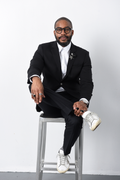
Mitchell S Jackson is a contributing writer for Esquire. He is the winner of a Pulitzer Prize and a National Magazine Award as well as the acclaimed author of the memoir Survival Math, and the award-winning novel The Residue Years. He is the John O. Whiteman Dean's Distinguished Professor of English at Arizona State University.


